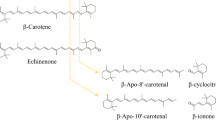Abstract
The allelopathic effect of the cyanobacterium Tychonema bourrellyi against the cyanobacterium Microcystis aeruginosa is reported for the first time in this paper. The filtrate of T. bourrellyi CHAB663 culture showed strong inhibitory effect on M. aeruginosa NIES-843, but the inhibitory effect was weakened by shaking culture, and such results implied that the allelopathic effect was probably mediated by the volatile substances secreted by T. bourrellyi. β-Ionone was identified as a major ingredient in the volatile substances in the cultures of T. bourrellyi, and it may act as an important allelochemical responsible for this allelopathic activity. The filtrates of T. bourrellyi culture were shown to decrease the maximum electron transport rate (ETRmax) and elevate the reactive oxygen species (ROS) levels in the cells of M. aeruginosa NIES-843.






Similar content being viewed by others
References
Azevedo SM, Carmichael WW, Jochimsen EM, Rinehart KL, Lau S, Shaw GR, Eaglesham GK (2002) Human intoxication by microcystins during renal dialysis treatment in Caruaru, Brazil. Toxicology 181–182:441–446
Doan NT, Rickards RW, Rothschild JM, Smith GD (2000) Allelopathic actions of the alkaloid 12-epihapalindole E isonitrile and calothrixin A from cyanobacteria of the genera Fischerella and Calothrix. J Appl Phycol 12:409–416
Griffiths HR (2005) Chemical modifications of biomolecules by oxidants. The handbook of environmental chemistry, vol 2. Springer, New York, pp 33–62
Gross EM, Hilt S, Lombardo P, Mulderij G (2007) Searching for allelopathic effects of submerged macrophytes on phytoplankton—state of the art and open questions. Hydrobiologia 584:77–88
Hirata K, Yoshitomi S, Dwi S, Iwabe OAM, Polchai J, Miyamoto K (2003) Bioactivities of nostocine A produced by a freshwater cyanobacterium Nostoc spongiaeforme TISTR 8169. J Biosci Bioeng 95:512–517
Hong Y, Hu HY, Li FM (2008) Physiological and biochemical effects of allelochemical ethyl 2-methyl acetoacetate (EMA) on cyanobacterium Microcystis aeruginosa. Ecotoxicol Environ Saf 71:527–534
Ichimura T (1979) Media for freshwater cyanobacteria. In: Nishizawa K, Chihara M (eds) Methods in phycology. Kyouritsu Shuppan, Tokyo, pp 295–296
Inderjit, Dakshini KMM (1994) Algal allelopathy. Bot Rev 61: 28–44
Jančula D, Maršálek B (2011) Critical review of actually available chemical compounds for prevention and management of cyanobacterial blooms. Chemosphere 85:1415–1422
LeGresley M, McDermott G (2010) Counting chamber methods for quantitative phytoplankton analysis—haemocytometer, Palmer-Maloney cell and Sedgewick-Rafter cell. In: Karlson B, Cusack C, Bresnan E (eds) Microscopic and molecular methods for quantitative phytoplankton analysis. UNESCO, Paris, pp 25–30
Li H, Hou G, Dakui F, Xiao B, Song L, Liu Y (2007) Prediction and elucidation of the population dynamics of Microcystis spp. in Lake Dianchi (China) by means of artificial neural networks. Ecol Inform 2:184–192
Manage PM, Kawabata Z, Nakano SI (2000) Algicidal effect of the bacterium Alcaligenes denitrificans on Microcystis spp. Aquat Microb Ecol 22:111–117
Marshall HJ, Geider RJ, Flynn KJ (2000) A mechanistic model of photoinhibition. New Phytol 145:347–359
Mehner C, Müller D, Krick A, Kehraus S, Löser R (2008) A novel β-amino acid in cytotoxic peptides from the cyanobacterium Tychonema sp. Eur J Org Chem 10:1732–1739
Molisch H (1937) Der Einfluss einer Pflanze auf die andere–allelopathie. Fisher, Jena
Mu RM, Fan ZQ, Pei HY, Yuan XL, Liu SX, Wang XR (2007) Isolation and algae-lysing characteristics of the algicidal bacterium B5. J Environ Sci (China) 19:1336–1340
Nishiyama Y, Allakhverdiev SI, Murata N (2006) A new paradigm for the action of reactive oxygen species in the photoinhibition of photosystem II. Biochimica et Biophysica Acta 1757:742–749
Østensvik Ø, Skulberg OM, Underdal B, Hormazabal V (1998) Antibacterial properties of extracts from selected planktonic freshwater cyanobacteria—a comparative study of bacterial bioassays. J Appl Microbiol 84:1117–1124
Ozaki K, Ohta A, Iwata C, Horikawa A, Tsuji K, Ito E, Ikai Y, Harada K (2008) Lysis of cyanobacteria with volatile organic compounds. Chemosphere 71:1531–1538
Rice EL (1984) Allelopathy, 2nd edn. Academic Press, Orlando
Shao J, Xu Y, Wang Z, Jiang Y, Yu G, Peng X, Li R (2011) Elucidating the toxicity targets of β-ionone on photosynthetic system of Microcystis aeruginosa NIES-843 (Cyanobacteria). Aquat Toxicol 104:48–55
Sharma NK, Tiwari SP, Tripathi K, Rai AK (2011) Sustainability and cyanobacteria (blue-green algae): facts and challenges. J Appl Phycol 23:1059–1081
Takamo K, Igarashi S, Mikami H, Hino S (2003) Causation of reversal simultaneity for diatom biomass and density of Phormidium tenue during the warm season in eutrophic Lake Barato, Japan. Limnology 4:73–78
Volk RB (2005) Screening of microalgal culture media for the presence of algicidal compounds and isolation and identification of two bioactive metabolites, excreted by the cyanobacteria Nostoc insulare and Nodularia harveyana. J Appl Phycol 17:339–347
Volk RB, Furkert FH (2006) Antialgal, antibacterial and antifungal activity of two metabolites produced and excreted by cyanobacteria during growth. Microbiol Res 161:180–186
Wu JT, Kuo-Huang LL, Lee J (1998) Algicidal effect of Peridinium bipes on Microcystis aeruginosa. Curr Microbiol 37:257–261
Wu Y, Liu J, Yang L, Chen H, Zhang S, Zhao H, Zhang N (2011) Allelopathic control of cyanobacterial blooms by periphyton biofilms. Environ Microbiol 13:604–615
Ye W, Liu X, Tan J, Li D, Yang H (2009) Diversity and dynamics of microcystin-producing cyanobacteria in China's third largest lake, Lake Taihu. Harmful Algae 8:637–644
Acknowledgments
The research was supported by National Natural Science Foundation of China (no. 21107024), and Foundation of Furong scholar project of Hunan Province.
Author information
Authors and Affiliations
Corresponding author
Rights and permissions
About this article
Cite this article
Shao, J., Peng, L., Luo, S. et al. First report on the allelopathic effect of Tychonema bourrellyi (Cyanobacteria) against Microcystis aeruginosa (Cyanobacteria). J Appl Phycol 25, 1567–1573 (2013). https://doi.org/10.1007/s10811-012-9969-z
Received:
Revised:
Accepted:
Published:
Issue Date:
DOI: https://doi.org/10.1007/s10811-012-9969-z




